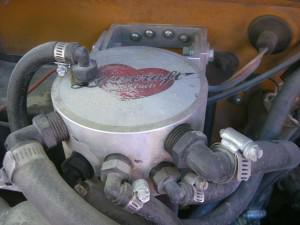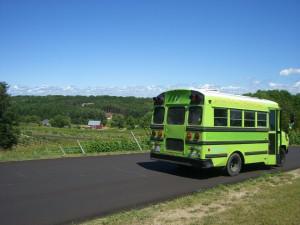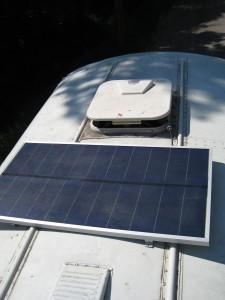 I should take a moment to describe the Lovecraft Biofuel conversion done on our bus. To safeguard against any particles that might bypass the filtration system, an additional inline fuel filter causes the engine to stall when clogged, preventing potentially irreparable engine damage. This inline filter came in handy when we broke down in Utah and merely needed to clean it to continue to Colorado. Additionally, the fuel filter was replaced with a heat exchanger, tapping directly into the coolant line, utilizing waste heat to preheat the vegetable oil. Other than changing out a couple of supply lines, the only other significant changes were the addition of an inline fuel pump to improve efficiency when the engine started from cold, and a return line to pump excess fuel back into the tank, further heating the cold oil by mixing it with already hot oil. This conversion allowed for the use of biodiesel, petrodiesel, or waste vegetable oil.
I should take a moment to describe the Lovecraft Biofuel conversion done on our bus. To safeguard against any particles that might bypass the filtration system, an additional inline fuel filter causes the engine to stall when clogged, preventing potentially irreparable engine damage. This inline filter came in handy when we broke down in Utah and merely needed to clean it to continue to Colorado. Additionally, the fuel filter was replaced with a heat exchanger, tapping directly into the coolant line, utilizing waste heat to preheat the vegetable oil. Other than changing out a couple of supply lines, the only other significant changes were the addition of an inline fuel pump to improve efficiency when the engine started from cold, and a return line to pump excess fuel back into the tank, further heating the cold oil by mixing it with already hot oil. This conversion allowed for the use of biodiesel, petrodiesel, or waste vegetable oil.
In addition to our objectives of designing and operating our filtration system, recycling waste vegetable oil, and exploring our country, we volunteered at music festivals, allowing us free admission and a chance to continue our green footprint. Our first music festival was Rothbury 2008, in Michigan, designed to be one of the first environmentally friendly, sustainable festivals. We were part of the “Green Team,” in charge of ensuring as close to zero-waste as possible by directing people where to toss their respective refuse as either compostable, recyclable, or landfill.

At this point we had decided that a heating method was necessary in order to decrease the time for the oil to settle prior to pumping it through our series of filters. I have since discovered that heating the oil, although necessary for lowering the viscosity of the oil before entering the engine, is not necessarily a good idea prior to filtration, because it will melt the fats and allow them to pass through the filter, potentially clogging the fuel lines. Analogous to one’s diet, this is why hydrogenated oils are bad for the engine. I suspect that some of the mechanical issues we faced during our bus trip were due in part to the clogging of the engine due to fats and impure oil.
Perhaps naively, we thought some of our troubles thus far were derived from the oil being too viscous entering the engine. With the expertise of our engineering guest traveler, Casey, we fashioned a heating coil that we would hang in our 50-gallon oil drum to heat the oil before filtering. We were under the false impression that heating would enable us to filter the oil without needing to settle it for one to fourteen days as recommended. We originally purchased an alternator for the bus to plug our heating coil in and run it off the bus’s battery, but ran into technical difficulties. We decided instead to attempt to “borrow” electricity along the way to plug our heating coil in at each filtering juncture. This lead to some incredible interactions with strangers, as can be imagined.

We continued North from Michigan after our music festival, stopping over in Traverse City for wine tasting and exploration of Sleeping Bear Dunes. We drove over Mackinaw Bridge and through the Northern part of Wisconsin before entering Minnesota, spending a week in Jen’s family’s quaint cabin on little Cass Lake. Reading, fishing, cooking, and narrowly missing a tornado, filled our laid-back time in the sleepy town outside of Bemidji. From here we headed south towards Minneapolis, which we discovered to be an incredibly green and bike-friendly city. After one night in the city, we were on our way to Hannibal, Missouri, where little did we know we would be staying for a week while our bus was under maintenance. Although we didn’t plan to spend so much time in the Midwest, I have to say that it was quite a reality check to see where a huge portion of the rest of our nation hails from. Much of the city was still under water or being repaired due to a massive Mississippi River flood in June, the largest to hit Hannibal since 1993. With Mark Twain being the biggest tourist attraction in Hannibal, this town of near 18,000 got quite a kick out of three young girls strolling through town with a keen eye for non-hydrogenated waste veggie oil. Needless to say, Japanese restaurants with clean grease were becoming few and far between in the Midwest.

